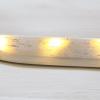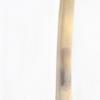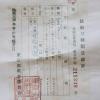Hello everybody! |
|||
 |
Nihonto ClubJapanese Sword Information Exchange |
User login |
|
|
Disclaimer: Nihontō Club owners and independent contributors will not be held responsible for any loss, damage or inconvenience caused as a result of any inaccuracy or error within this website. Except where otherwise noted, this page is licensed under a Creative Commons License.
|







Kaibu Ju Ujitsugu
Hi Oliver,
The shape of the blade is called kata-kiriha-zukuri. You may read about it here.
I think the signature reads:
There are 4 smiths from Kaifu school with name Ujitsugu: UJI183, UJI184, UJI185, UJI186. Works of Ujitsugu are very rare and I couldn't find any oshigata to compare your blade to.
Regards,
Stan
Kaibu Ju Ujitsugu
Dear Stan!
Thank you very much for your message, it has helped me to understand much things!
Two more question: 1) Whether you can something tell me about this certificate? Its what organization gives out and about what it speaks?
2) You write on a sword is written the smith from KAIBU. And then write that them 4 of KAIFU school. What is it: the typing error or is two versions of the name of the same areas?
Once again many thanks!
Regards, Oliver.
oliver
Oshigata
Hi Oliver,
1) oshigata is a traditional way to record properties of the blade in the form of a hand drawn image and rubbings of the tang. See more examples here. It would be very helpful if we find oshigata of other blades of the smiths listed above in order to compare them with your sword.
2) Yes, according to sword books the school/place is referred both as Kaifu and Kaibu. It is also mentioned that BU in 'Kaibu' was written in a number of different ways. I don't know exactly why, but it's not uncommon. You should also take into account that the way signatures are written on the tang is not always the same as you would find in the books or on this website. Without even mentioning the differences in written style and typography, some characters may be written using a more modern (e.g. you'll always find 国 instead of 國 in the modern books) or simply an alternative version of the kanji (but with the same pronunciation). It's even more complicated with romanised forms as there may be 2 or even more ways to read it and all of them would be correct. The ability to read signatures requires a great deal of knowledge of Japanese language, writing and art signatures. This is another reason why oshigata would help greatly.
Regards,
Stan